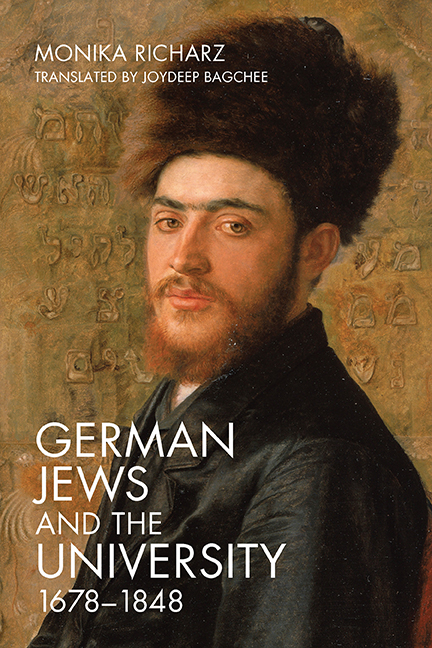Book contents
- Frontmatter
- Dedication
- Contents
- Foreword to the English Edition
- Foreword to the German Edition
- Preface to the German Edition
- Translator’s Note
- List of Abbreviations
- 1 Jewish Education in the Enlightenment Era
- 2 Jewish Encounters with the University before Emancipation
- 3 Jewish Students in the First Half of the Nineteenth Century
- 4 The Social Situation of Jewish Students in the pre-1848 Era
- 5 The Professional Experience of Jewish University Graduates
- Conclusion
- Documents
- Bibliography
- Index
4 - The Social Situation of Jewish Students in the pre-1848 Era
Published online by Cambridge University Press: 15 September 2022
- Frontmatter
- Dedication
- Contents
- Foreword to the English Edition
- Foreword to the German Edition
- Preface to the German Edition
- Translator’s Note
- List of Abbreviations
- 1 Jewish Education in the Enlightenment Era
- 2 Jewish Encounters with the University before Emancipation
- 3 Jewish Students in the First Half of the Nineteenth Century
- 4 The Social Situation of Jewish Students in the pre-1848 Era
- 5 The Professional Experience of Jewish University Graduates
- Conclusion
- Documents
- Bibliography
- Index
Summary
Their Background
MOST JEWISH STUDENTS in the eighteenth century were from large Jewish communities. Occasionally, smaller Jewish settlements such as those in Düsseldorf or Göttingen provided larger numbers of students. But these were exceptional cases, which were rooted in specific circumstances. These conditions started to change by the early nineteenth century. The interest in extra-Jewish knowledge and in academic studies captivated ever larger circles and gained in social prestige in the measure that Jewish tradition was neglected. Naturally, the new professional opportunities that emancipation legislation, for all its restrictions, had opened up for Jewish university graduates also played a role. Yet another factor was the growth in the Jewish population, which outstripped even the rapid increase in the general population and created ever greater demand for university graduates and, above all, for doctors within Jewish communities as well. Ever more Jews from midsized and smaller communities now studied at universities. Thirty-eight percent of Jewish students at the University of Heidelberg and a mere 18 percent of students at the University of Bonn came from communities numbering 1,500 or more Jewish inhabitants around the mid-nineteenth century. In Bonn, Jews from larger communities such as Düsseldorf, Cologne, Bonn, and Koblenz comprised roughly 42 percent of Jewish students, whereas in Heidelberg, Jews from midsized communities such as Hannover, Hanau, Darmstadt, Mainz, Worms, and Munich comprised 24 percent of Jewish students. By contrast, the ratio of Jewish students from small Jewish settlements and Jewish village settlements was 38 percent in Heidelberg and 40 percent in Bonn. Nonetheless, as was also the case among Christians, the purely rural population was less represented at universities. This explains, for instance, the poor attendance at universities such as Tübingen, which was in a district that almost exclusively contained rural Jewish settlements. This can be attributed both to the poorer economic situation of the rural Jewish population on average (which, in any case, was relatively small) and to the lack of suitable educational facilities in rural areas. Many of the students from rural communities later settled in cities so that university study led to a further concentration of Jews in cities.
- Type
- Chapter
- Information
- German Jews and the University, 1678-1848 , pp. 145 - 179Publisher: Boydell & BrewerPrint publication year: 2022

